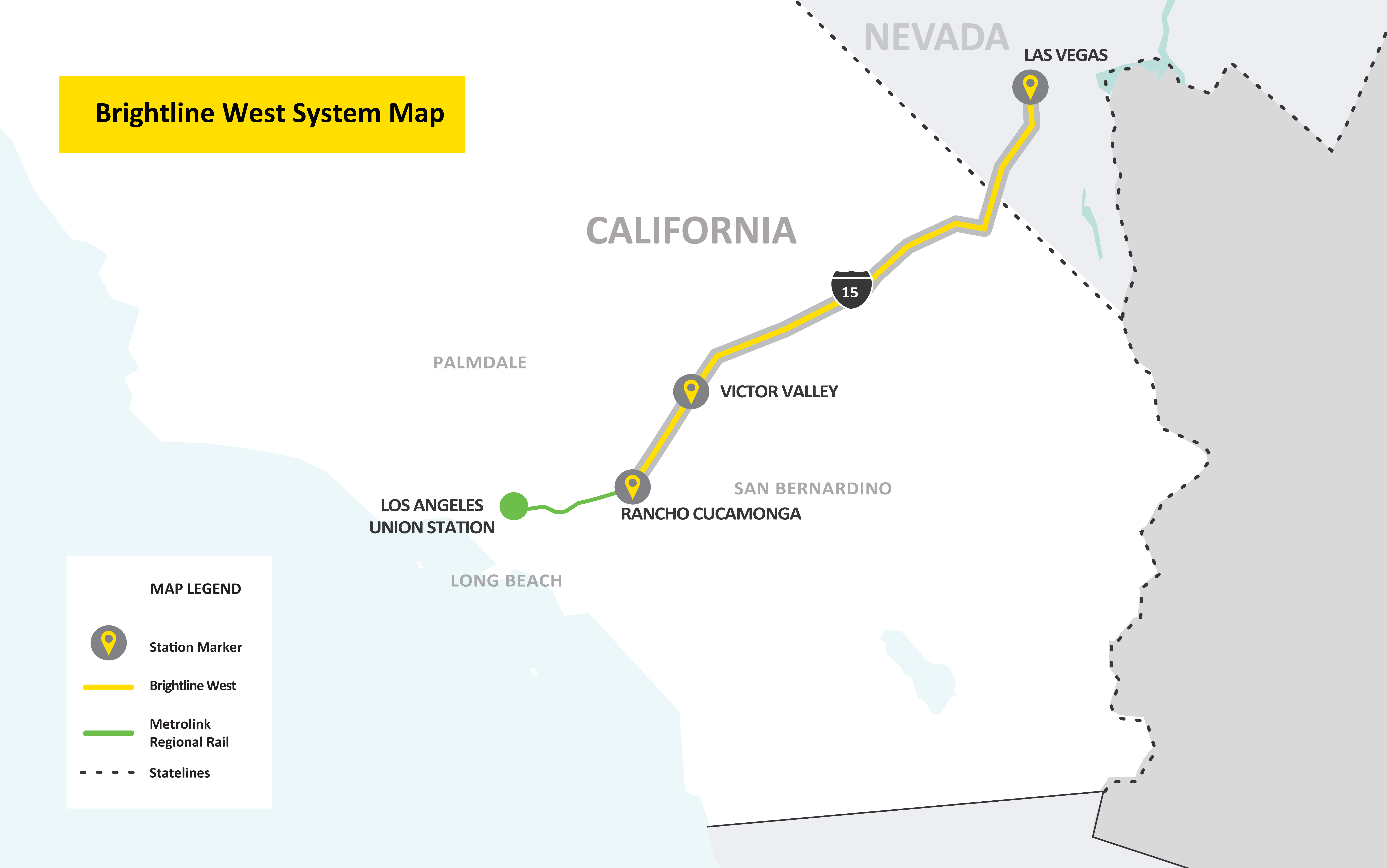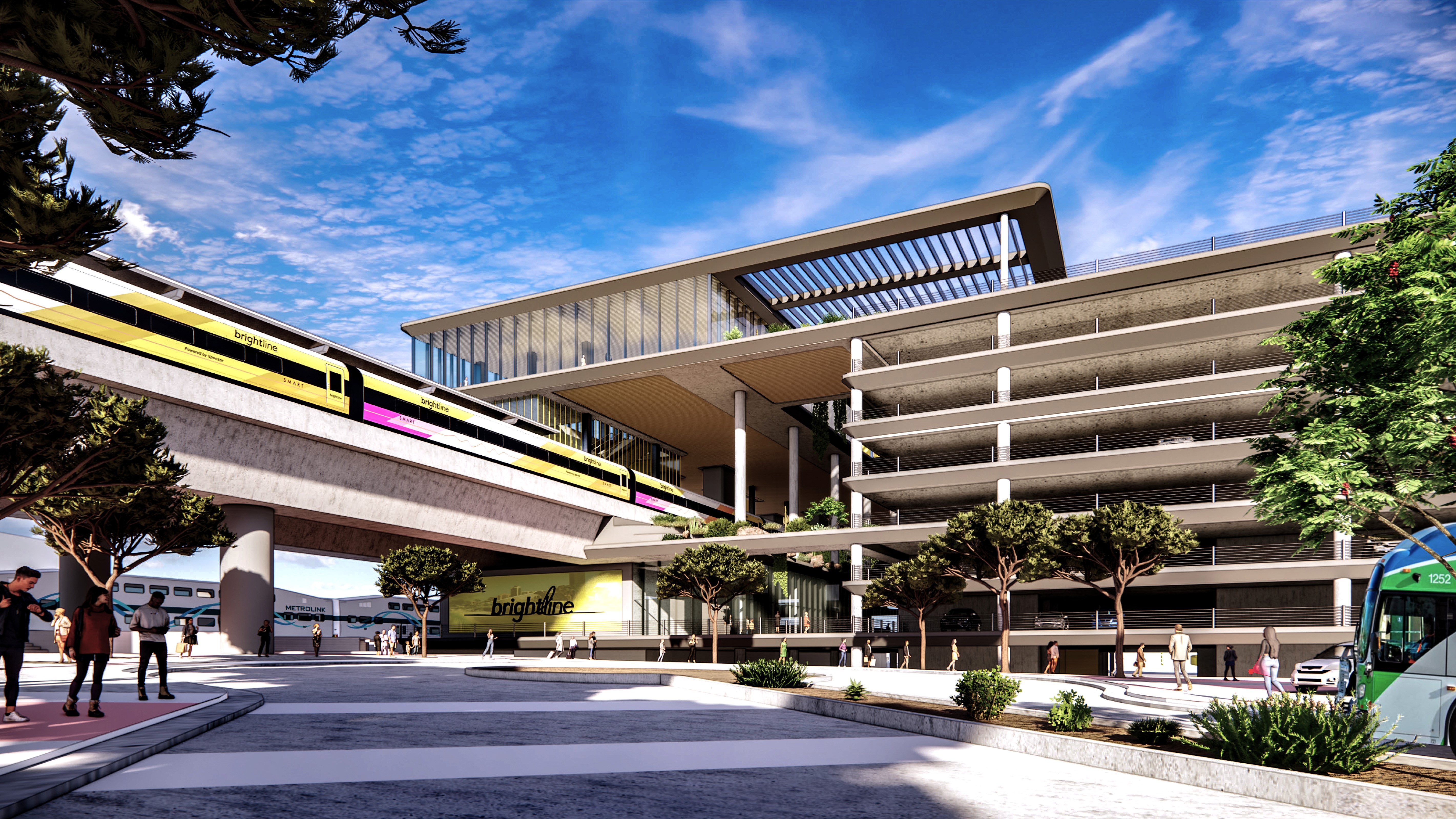Any planner in California who has followed the various sagas of high speed rail knows better than to daydream too much about station-area planning. The state’s north-south system, approved many years ago, is woefully behind schedule and over-budget, much to the dismay of cities in the Central Valley.
But, in a different corner of the state excitement is building — possibly with good reason.
Last month, Brightline West, a privately developed high-speed rail line connecting Rancho Cucamonga with Las Vegas, received $2.5 billion in private activity bonds from the U.S. Department of Transportation, bringing the $12-billion project one step closer to groundbreaking. All told, the project has received nearly $9 billion in federal loans and grants.
Though various versions of Brightline West project have come and gone since 2005, optimism is running high now. The company already opened a line in Florida — connecting South Florida with Orlando — and believes that connecting the Los Angeles area to Las Vegas could, finally, usher in the era of high-speed rail in the United States.
Brightly expects to hire 11,000 construction workers in the coming months. And, for Rancho Cucamonga Deputy City Manager Matt Burris, the progress is even more palpable than that. Burris said that, recently, Brightline workers have been taking soil samples in and around the station area.
“It was pretty cool to see a drill rig,” said Burris. “That’s serious work. They are moving forward.”

If those soil samples give way to a ribbon-cutting on-schedule in 2027 — Brightline wants to operate a the line for a full year in advance of the 2028 Olympics in Los Angeles — the line could transform Rancho Cucamonga, link exurban desert communities to Los Angeles, and boost the economy of the entire Inland Empire.
“If those jobs are located in the vicinity of the new transit service, that’s a good thing,” said Rafa Sonnenfeld, policy director for YIMBY Action. “Having more amenities and destination along that transit corridor is what will make that transit corridor successful. There’s a lot of potential for transit-oriented development in those communities with this new spine of Brightline.”
In total, the line will run 218 miles, largely within the median of Interstate 15, at speeds to up to 186 miles per hour. The line will briefly travel through the heavily urbanized areas of the western Inland Empire, then go through the Cajon Pass, and travel 185 miles mostly unimpeded through the Mojave Desert. The right-of-way offers distinct advantages: the line will be built in an already developed area, with easy access for construction crews, and it will only minimally disrupt the desert habitat that lines the majority of the route.
The company reached an agreement with the California Department of Transportation to develop the Hesperia-Rancho Cucamonga leg in March.
“We’ve done maybe the most difficult steps,” said Ben Porritt, Brightline’s senior vice president for corporate affairs. “Step one is securing our land in all of our right of way, an existing corridor that’s already environmentally disturbed.”
In 2016, back when Brightline West’s predecessor, DesertXpress (see related CP&DR coverage), intended to terminate in Victorville, the City of Rancho Cucamonga adopted a progressive specific plan for the area around its Metrolink Station. The city took over an underutilized 160-acre golf course and envisioned medium-density commercial and residential development. Today, the Lewis Group, a prominent Inland Empire developer, is building on the southern end of that plan area, while the northern end remains mostly undeveloped.
Brightline is likely to stir interest from developers who want to build out the plan area.
“We’re seeing greater interest in some of the underdeveloped properties in the vicinity of the station,” said Burris.
Regardless of whether the train arrives, the city believes that this sort of development is appropriate for Rancho Cucamonga no matter what. The city is required to zone for 10,525 additional units according to its 6th Cycle Regional Housing Needs Allocation. Burris said that it makes sense to concentrate development in a few key areas so that it does not encroach on the city’s vast swaths of single-family neighborhoods.
“One of the strategies laid out in the general plan is that we’re going to accommodate the vast majority of our growth in a couple key corridors and nodes,” said Burris. “It really resonated with the community to come up with a land use plan to protect the existing neighborhoods…but provide new amenities and destinations in close proximity to their neighborhood.”
“Having mixed use development with a lot of housing near that station is really promising,” said Sonnenfeld. “They’re planning for basically a TOD employment.”

While the city welcomes development near the station, other impacts remain uncertain. Brightline estimates that the line could carry 11 million annual trips at full capacity — for a daily average of just over 3,000. Those passengers will have the option of connection to the Rancho Cucamonga terminus via Metrolink commuter rail (which connects to downtown Los Angeles), local bus service, or, of course, private automobiles. The company is building a 5,000-stall parking garage at the station area to handle that demand.
The city’s streets could suffer if a disproportionate number of Brightline passengers opt for cars.
“We could see a good bit of traffic,” said Burris. “On the economic benefits side, we could see increased demand for office, professional, and hospitality associated with tourism.”
(Currently, an estimated 50 million car trips are currently taken annually between the Los Angeles metro area and southern Nevada, in addition to more than 2 million commercial air passengers between Las Vegas and the region’s four airports.)
The company is collaborating with Metrolink and local bus systems to avoid this scenario. Metrolink has pledged to increase frequencies and synchronize its schedule with that of Metrolink. Metrolink and Brightline are also discussing a ticket that would allow for seamless transfers between the systems.
“We are moving our model not away from the commuter but beyond the commuter,” said Metrolink CEO Darren Kettle. “More evening trains, more midday trains, trains targeted for trips for different reasons; we’re already going in that direction. I think Brightline will highlight the importance of that effort.”
Even so, Burris says that there are many unknowns — and no meaningful precedents.
“We’re not exactly sure what the impacts will be,” said Burris. “We haven’t found a good analog for this type of thing in the United States to see how it functions to understand what it means in terms of economic impact or potential benefits. There isn’t an interstate high-speed rail station within a couple miles of an international airport (Ontario) that connects to a commuter rail system for a multimillion-person region.”
Burris linked Brightline to a small commercial airport being dropped into a city, with “similar impacts and benefits.”
Though Brightline owns, and intends to develop, a large swath of land at its Las Vegas terminus, at the southern end of the Las Vegas Strip, it has expressed no such ambitions in Rancho Cucamonga.
“Brightline has not spent a lot of time talking with us about that,” said Burris. “What they shared with us was their focused needed to be on getting their permitting, getting all their agreements in place, getting their funding in place, and getting the line under construction.”
Prospects are, arguably, even less certain for its one intermediate station.
Brightline’s “Victor Valley” station — to be located in an undeveloped area on the northern end of the City of Apple Valley, and closely adjacent to Hesperia and Victorville — is not likely to generate much ridership on its own. But it’s being designed, in part, to connect, via a spur that is as-yet unplanned and unfunded, with a future Palmdale station on the state high-speed rail line.
“We look at California High Speed Rail as simply a different model to get to the same goal that we have,” said Porritt. “We’ll certainly root for that project and ultimately connect to that project, and we would serve as the east-west and they as the north-south.”
In the meantime, passengers will be able to park and catch the train in Apple Valley — both for trip to Las Vegas and to Rancho Cucamonga. As part of its collaboration with the San Bernardino County Transportation Authority, Brightline will welcome passengers who use the train as commuter rail, presumably from less expensive housing in the high desert to the job centers of the Inland Empire — and, possibly, to those of Las Vegas as well.
“What I think this project also does is sort of reverses the commute,” said Assistant Town Manager Orlando Acevedo. “Folks will start to look to the Las Vegas metro as another job area to do business or even commute.”
Traditional transit-oriented development in Apple Valley is unlikely, especially since the station area is currently bare desert. But Acevedo said that it could direct the city’s growth.
“We know it’ll have significant impact on north Apple Valley,” said Acevedo, who noted that the city is only 30% built-out. “The project will extend water, sewer, roads to the site. “Brightline will help extend infrastructure to this area , and that will really open the door and catalyze development opportunities in north Apple Valley.”
While housing advocates are often wary of exurbanization, especially in environmentally sensitive areas, Sonnenfeld noted that Apple Valley is supposed to add 4,290 homes according to its RHNA numbers no matter what.
“They have a housing shortage and need to grow,” said Sonnenfeld. “The fact that there is already a city there means that that city needs to accommodate the needs of its current and future residents. Whether or not that city should exist in the first place is a philosophical question. But, the reality is, Apple Valley exists.”
“We’ve only just begun to scratch the surface of what that means for job creation in the high desert and residential development,” said Acevedo.
Contacts & Resources
Brightline West: Project Overview
Cucamonga Station Area Plan
Prior CPD&R Coverage: Victorville Hopes to Capitalize on Las Vegas Bullet Train, December 4, 2011
Orlando Acevedo, Assistant Town Manager, City of Apple Valley, OAcevedo@applevalley.org
Matt Burris, Deputy City Manager, City of Rancho Cucamonga, matt.burris@cityofrc.us
Darren Kettle, CEO, Metrolink, https://metrolinktrains.com/news/metrolink-news/
Ben Porritt, Senior Vice President for Corporate affairs, Brightline, ben@gobrightline.com
Rafa Sonnenfeld, Policy Director, YIMBY Action, rafa@yimbyaction.org
Images courtesy of Brightline West
A version of this article appeared in InTransition Magazine (with sidebar) in October 2023.
